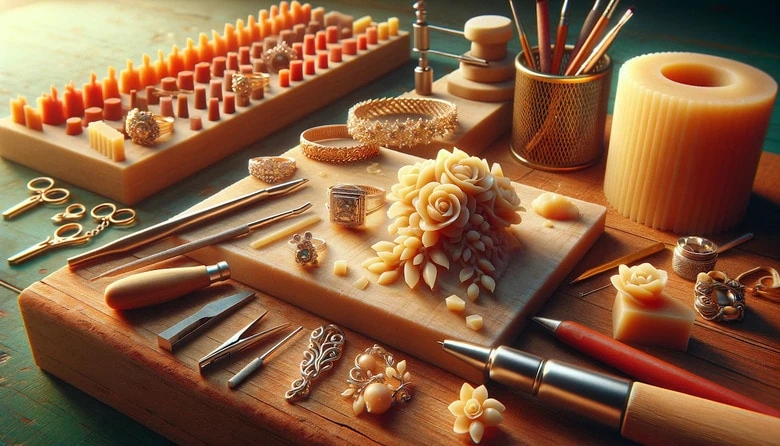
The art of wax in jewelry making, a cornerstone of the lost wax casting process, is a fascinating blend of ancient tradition and modern innovation.
The art of wax in jewelry making, a cornerstone of the lost wax casting process, is a fascinating blend of ancient tradition and modern innovation.
This technique, dating back thousands of years, remains integral to creating intricate and beautiful jewelry pieces.
It involves sculpting jewelry designs in wax, which is then encased in a molding material.
Upon heating, the wax melts away, leaving a perfect cavity for molten metal to be poured in, thus forming the jewelry piece.
This process not only allows for exceptional detail and creativity in design but also bridges the gap between artistic vision and tangible art.
Through this guide, we delve into the nuanced world of wax in jewelry making, exploring its techniques, applications, and the magic it brings to the creation of each piece.
The Historical Significance of Wax in Jewelry Making
The use of wax in jewelry making is steeped in a rich historical tapestry that spans across various civilizations and eras, each adding its layer of innovation and artistry to the craft.
This ancient technique has played a pivotal role in the evolution of jewelry design, allowing artisans to push the boundaries of creativity and precision.
As we explore the historical significance of wax in jewelry making, we uncover a chronicle of human ingenuity, where the melding of simple materials and fire birthed treasures of immeasurable beauty and cultural value.
This journey through time not only highlights the technical advancements in the craft but also reflects the changing aesthetics and values of societies, making wax an enduring symbol of artistic expression in the realm of jewelry making.
Origins and Evolution
The origins of wax in jewelry making trace back to ancient civilizations, where early artisans discovered the transformative power of combining heat with malleable substances to create intricate adornments.
This journey begins in the realms of ancient Mesopotamia and Egypt, where the earliest examples of lost wax casting date as far back as 4,000 years ago.
These civilizations utilized beeswax to craft detailed amulets, decorative items, and religious symbols, setting the stage for a practice that would span continents and epochs.
As we move through history, the technique found its way into the hands of Greek and Roman jewelers, who refined the art to produce pieces of remarkable detail and beauty.
The Romans, on the other hand, introduced new levels of complexity in their designs, incorporating a wide range of gemstones and metals into their wax-based creations.
The Middle Ages saw the continued evolution of wax in jewelry making, with European artisans adopting and adapting these ancient techniques to suit the styles and sensibilities of the medieval period.
The Renaissance marked a significant turning point in the history of wax in jewelry making.
A renewed interest in the arts and sciences led to innovations in techniques and materials, with artisans like Benvenuto Cellini pushing the boundaries of what could be achieved.
In the centuries that followed, the art of wax in jewelry making continued to evolve, influenced by the changing tastes, technologies, and materials available to jewelers.
The Industrial Revolution brought about new challenges and opportunities, with mechanization changing the landscape of manufacturing.
However, the fundamental techniques of wax modeling remained valued for their ability to produce unique, highly detailed pieces.
Today, the legacy of those ancient artisans is alive in the workshops of modern jewelers, who continue to rely on wax modeling as a vital step in the jewelry-making process.
The advent of digital technologies has introduced new dimensions to the craft, allowing for precision and complexity that would have been unimaginable to those early pioneers.
Also Read: What Is Costume Jewelry and How Is It Unique?
Cultural Impact
The cultural impact of wax in jewelry making extends far beyond its technical contributions to the craft, embedding itself deeply within the social fabric of numerous societies across the globe.
This impact is most vividly observed in the way different cultures have infused wax-crafted jewelry with layers of meaning, symbolism, and identity.
In many traditions, jewelry crafted through wax techniques is not merely decorative but carries significant cultural narratives, embodying the collective memory, beliefs, and aspirations of a community.
Modern Adaptations
Modern adaptations of wax in jewelry making reflect a seamless fusion of tradition and innovation, where ancient techniques meet cutting-edge technology.
Today’s artisans embrace digital tools, such as 3D printing, to create wax models with unparalleled precision and complexity, revolutionizing the design process.
This digital approach enables the crafting of pieces that would have been impossible or prohibitively time-consuming by traditional means.
Techniques of Wax Modeling in Jewelry Making
Wax modeling in jewelry making represents a unique intersection of art and craftsmanship, serving as the foundation for translating imaginative designs into tangible pieces of jewelry.
This intricate process encompasses a range of techniques, each requiring a deep understanding of the material’s properties and potential.
From the initial sketch to the final wax model ready for casting, artisans employ methods that combine age-old traditions with modern innovations.
As we delve into the techniques of wax modeling, we uncover the meticulous steps involved in sculpting, molding, and refining wax to create models that capture the essence of the jeweler’s vision.
This exploration not only reveals the technical prowess required in wax modeling but also illuminates the creative possibilities it unlocks, enabling the creation of pieces that are as diverse in style as they are rich in detail.
Carving
Carving in wax jewelry making stands as a testament to the artisan’s precision and creativity, allowing for the realization of intricate designs that are rich in detail and texture.
This hands-on technique involves the meticulous removal of wax to sculpt and define the jewelry piece’s form and features.
Utilizing a variety of specialized tools, from delicate engraving needles to more robust carving instruments, artisans can achieve a range of effects, from the finely detailed to the boldly sculptural.
Molding and Casting
Molding and casting in wax jewelry embodies the transformative journey from a wax sculpture to a metal masterpiece.
This phase starts with the encapsulation of the carved wax model in a heat-resistant investment material, forming a mold.
Upon hardening, this mold undergoes a heating process where the wax is melted and evacuated, leaving behind a precise cavity in the shape of the original design.
It’s in this void that molten metal, chosen for its beauty and durability, is poured.
Once cooled, the investment is removed to reveal the metal piece, which retains even the most intricate details of the wax model.
Finishing Touches
The finishing touches in wax jewelry making mark the culmination of the transformation process, where the raw cast piece is refined into a polished work of art.
This stage is characterized by meticulous detailing and surface finishing, ensuring that each jewelry piece achieves its intended aesthetic and tactile qualities.
Applications and Innovations
The realm of wax in jewelry making is a vibrant landscape of applications and innovations, continuously evolving to embrace new techniques and technologies.
This dynamic facet of jewelry design not only offers unparalleled opportunities for custom and bespoke creations but also serves as a playground for artistic exploration and technological integration.
As we explore the various applications of wax modeling, from personalized jewelry pieces to avant-garde designs, we also delve into the cutting-edge innovations that are reshaping the industry.
This includes the advent of 3D printing and other digital tools that have expanded the horizons of what can be achieved with wax.
Custom Jewelry Design
Custom jewelry design, facilitated by wax modeling, offers a personalized approach to creating unique pieces that reflect individual stories and styles.
This bespoke process begins with a collaboration between the artisan and client, translating personal visions into detailed wax models.
Artistic Expression
Artistic expression in wax jewelry making transcends traditional boundaries, allowing artists to explore and manifest their creative visions with unparalleled freedom.
Through this expressive medium, artists not only showcase their technical prowess but also communicate deeper meanings, emotions, and stories, connecting with wearers on a profound level.
Technological Integration
Technological integration in wax jewelry making heralds a new era of precision and possibility.
The advent of 3D printing technologies has revolutionized the traditional wax modeling process, enabling designers to create complex, detailed wax models directly from digital designs.
This synergy between digital artistry and traditional craftsmanship allows for the exploration of forms and structures previously unattainable, pushing the boundaries of jewelry design.
Are you ready to wear wax artwork?
In conclusion, the art of wax in jewelry making stands as a testament to human creativity and the perpetual pursuit of beauty through craftsmanship.
As we uncover the layers of this ancient yet ever-evolving technique, it becomes clear that the fusion of wax, metal, and gemstones does more than create jewelry; it weaves stories, embodies cultures, and captures imaginations.
Through understanding the techniques and applications of wax in jewelry making, we gain insight into a craft that continues to charm and innovate, bridging past and future in the creation of wearable art.
Source of information: https://www.scuoladioreficeria.it/en/professional-wax-micro-modelling-course-chisel-and-embossing/






